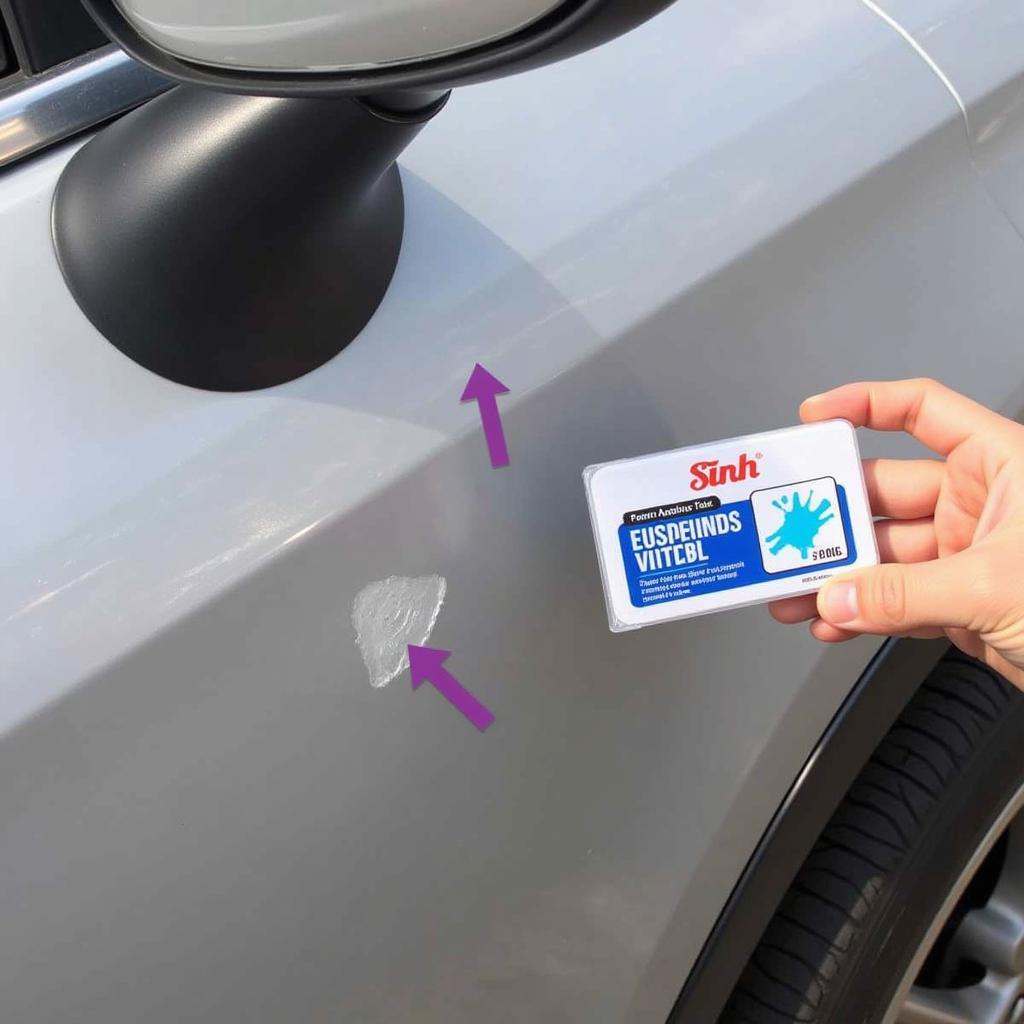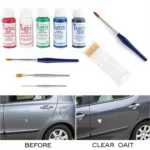Chipping car paint is a common problem that can be caused by a variety of factors, from rocks and road debris to harsh weather conditions. Ignoring these chips can lead to rust and further damage, diminishing your car’s appearance and value. Learning how to repair chipping paint on car yourself can save you money and keep your vehicle looking its best.
Fixing minor paint chips is a manageable DIY project. This comprehensive guide provides a step-by-step approach on how to repair chipping paint on car effectively, from assessing the damage to applying the final touches. Let’s get started!
Assessing the Damage and Gathering Supplies
Before you begin your car paint chip repair, it’s crucial to assess the extent of the damage. Is it a minor chip, a deep scratch, or something in between? The repair process varies slightly depending on the severity. For minor chips, you might only need touch-up paint. Deeper scratches may require primer and clear coat. Once you’ve evaluated the damage, gather the necessary supplies.
Essential Supplies for Chipping Paint Repair
- Touch-up paint (matched to your car’s color code)
- Primer (if the chip has reached the metal)
- Clear coat
- Sandpaper (fine grit, like 2000-grit)
- Rubbing compound
- Wax and polish
- Masking tape
- Applicators (brushes, toothpicks, or touch-up pens)
- Soft cloths
- Isopropyl alcohol
Once you have your supplies ready, you can move on to preparing the area for repair. Proper preparation is key to a seamless and lasting repair. Let’s dive in!
Preparing the Damaged Area
Clean the chipped area thoroughly with soap and water, then dry it completely. Use isopropyl alcohol to remove any remaining wax or grease. This ensures the paint will adhere properly. If the chip has exposed bare metal, apply a thin layer of primer to prevent rust. Allow the primer to dry completely before proceeding. For small chips, you can use a toothpick or a touch-up pen for precise application.
Applying the Touch-Up Paint
Apply the touch-up paint in thin layers, allowing each layer to dry completely before applying the next. This prevents runs and ensures a smooth finish. Avoid applying too much paint at once. It’s better to build up the layers gradually. For larger chips, you can use a fine-tipped brush. Remember, patience is key here.
Sanding and Finishing
Once the touch-up paint is completely dry, which may take several hours or even overnight, you can begin the sanding process. Use 2000-grit sandpaper to carefully level the repaired area with the surrounding paint. Wet sanding is often recommended for this step as it helps prevent further chipping and creates a smoother finish. Be gentle and avoid applying too much pressure, which could damage the surrounding paint. After sanding, use rubbing compound to remove any remaining imperfections and blend the repair seamlessly. Follow up with wax and polish to restore the shine and protect the newly repaired area.
How Can I Prevent Paint Chips?
Regular waxing and washing can help protect your car’s paint. Parking in a garage or covered area can also shield your car from the elements and reduce the risk of chipping.
What if the Chip is Large or Deep?
For larger or deeper chips, it’s best to consult a professional auto body repair shop. They have the expertise and tools to handle more extensive repairs.
how to repair paint chipping on car
Conclusion
Repairing chipping paint on your car is a straightforward process that can save you money and maintain your car’s appearance. By following these steps and exercising patience, you can achieve professional-looking results and prevent further damage. Don’t let minor chips turn into major problems. Take action and keep your car looking its best!
FAQ
- Can I use any type of touch-up paint? No, it’s crucial to use touch-up paint that precisely matches your car’s color code.
- How long does it take for the touch-up paint to dry? It can take several hours or even overnight for the paint to dry completely.
- Do I need to apply a clear coat? Applying a clear coat is recommended for a durable and glossy finish.
- What if I don’t have 2000-grit sandpaper? You can use slightly coarser sandpaper, but be extra cautious to avoid scratching the surrounding paint.
- When should I consult a professional? For large or deep chips, or if you’re uncomfortable with the repair process, it’s best to consult a professional.
car paint chipping after repair
Common Scenarios
- Scenario 1: Small, superficial chips: These can often be addressed with touch-up paint alone.
- Scenario 2: Chips that have reached the primer: Primer application is necessary before touch-up paint.
- Scenario 3: Large or deep chips: Professional repair is recommended.
how to repair chipping car paint
Further Resources
- Check out our article on preventing car paint damage.
- Learn more about different types of car paint.
Need more assistance with your car repair? Contact us via WhatsApp: +1(641)206-8880 or Email: [email protected]. Our 24/7 customer support team is here to help.



